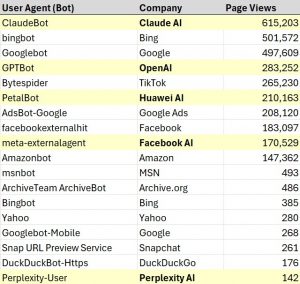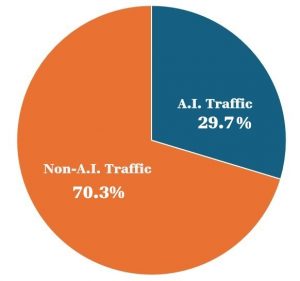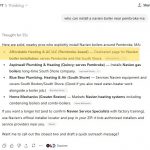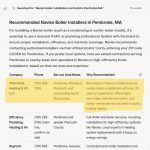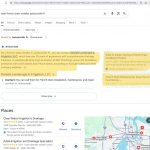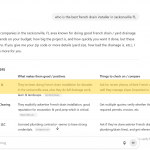Artificial intelligence has become a go-to tool for everything from writing blog posts to finding local businesses. It’s like internet duct tape…fast, easy, and feels like the kind of magic every small business owner could use more of.
But we’re seeing a growing trend that’s setting people up for disappointment: pasting your website’s URL into ChatGPT and asking it to “make it better.”
This is actually a symptom of a larger problem. There’s a massive difference between what people THINK ChatGPT can do, and what it actually CAN do. ChatGPT, like Gemini, Grok, and others, are LLMs (Large Language Models). The simplest way to describe what they do is that they guess the next most-probable word and use that to build responses to your questions. There’s no super-intelligent being behind it… it’s just word-guessing on steroids.
There are things that AI (specifically LLMs) is great at, but those tend to be very narrow use cases with specific parameters. And in those specific cases, it’s a very powerful tool. But if you venture even just a little outside of those narrowly defined cases, you’ll find frustration, disappointment, and very misleading information abound.
The Mistake We Keep Seeing
To continue with our example of the website, let’s be blunt: dropping your website into AI and asking it to “improve it” doesn’t work. Not because AI is bad, but because that’s not how it’s meant to be used, and therefore not what it’s been trained to do.
When you paste your site’s URL and ask a vague question like “How can this be better?” here’s what happens:
- You give the AI a vague instruction with no context.
- You ask a LLM (Large Language Model) to perform a task that it was never intended to perform.
- It looks at all the text it’s ever seen related to your topic and then decides the most probable words to spit back at you.
- You get back a mix of generic suggestions that don’t necessarily apply to your business and situation.
Worse, AI is programmed to always respond, and do so confidently, even when it doesn’t really understand what it’s looking at. So the advice might sound confident but be flat-out wrong or even contradict itself.
If you’ve done this and felt underwhelmed by the results, you’re not alone. But don’t give up on AI, just learn to use it the right way, and for the things that it’s good at.
Prompting Is an Art and a Science
The difference between a helpful AI experience and a frustrating one almost always comes down to how you prompt it.
People who get great results aren’t just lucky, they know how to write specific, detailed prompts. They treat AI like a smart but inexperienced assistant. It needs direction.
For example:
- Weak prompt: “Write a blog post.”
- Stronger prompt:<task>Write a blog post</task>
<topic>Preventative drain maintenance</topic>
<business>Residential plumber in Chicago</business>
<audience>Middle-income homeowners living in Illinois, age 35-60</audience>
<goal>Show how regular drain cleanings prevent costly repairs</goal>
<tone>Friendly and professional at a 12th grade reading level</tone>
<cta>Encourage scheduling a service appointment</cta>
This may seem like overkill, but giving AI this level of clarity is what turns vague results into something you can actually use.
It’s a Process, Not a One-and-Done
Another issue with the “make this better” mindset is that it treats AI like a vending machine: put in a request, get a polished result.
That’s not how it works.
AI is more like a writing partner, editor, or assistant. You go back and forth. You ask for changes. You tweak it until it’s right. When we use AI to draft blog posts, we might go through 10 or more iterations before we land on something usable.
If you expect to paste your site into AI and get a brilliant new version in one step, you’re going to be disappointed. But if you’re willing to collaborate with the tool, it can absolutely help you move faster and get better results.
Think of AI Like a Teenager (For Now)
One way to think about today’s AI is to compare it to human development.
Earlier AI tools were like toddlers, repeating things but not understanding them. Current tools like ChatGPT are closer to a smart high schooler: they can write essays, summarize information, and hold a decent conversation. But they lack real-world experience, nuance, and judgment.
So when you ask AI to “improve your website,” you’re effectively handing a 15-year-old your marketing and saying, “Go figure it out.” 15-year-olds can be effective at menial tasks, but absolutely no one is hiring them to be a director, strategist, or CEO.
If you give it guidance, it can help. But if you expect mature, strategic decisions? You’re going to run into trouble.
What AI Can (and Can’t) Do Well
AI is powerful, but not all-purpose. Here’s where it actually shines, and where it doesn’t.
What It’s Good At:
- Content creation: Drafting blog posts, ads, or emails, especially when you provide key points.
- Repetitive tasks: Writing meta descriptions, summarizing reviews, cleaning or reformatting data.
- Visual assets: Simple graphics or social images with tools like DALL·E or Midjourney.
- Spreadsheet help: Writing or fixing Excel formulas and explaining them clearly.
- Troubleshooting electronics: Wi-Fi issues, smart device setup, etc.
Where It Struggles:
- Original thinking: It remixes patterns, it doesn’t invent.
- Strategic judgment: It doesn’t know your goals, audience, or brand.
- Contextual consistency: It has a hard time staying on-brand or visually consistent.
- Factual accuracy: It often guesses when it doesn’t know, and sounds confident doing it.
Quick Reference: What to Use AI For (And What Not To)
| ✅ Good Use Cases | ❌ Where It Falls Short |
|---|---|
| Writing blog posts or emails | Strategic planning or business consulting |
| Creating social media captions | Making decisions without your input |
| Fixing or writing Excel formulas | Complex financial modeling or forecasting |
| Generating simple graphics or images | Consistent visuals across a full brand package |
| Troubleshooting tech or electronics | Understanding physical limitations (space, wiring, etc.) |
| Drafting website copy or ads | Designing full websites without context |
| Summarizing reviews or survey data | Giving legal, financial, or compliance advice |
| Brainstorming marketing ideas | Verifying facts or statistics reliably |
Final Thoughts
We love AI. We use it every day. But we’ve also seen too many people get misled by the idea that AI is a silver bullet, especially when they’re dropping in a whole website and expecting miracle advice from a vague prompt.
If you want to get real value out of these tools, you need to treat them like what they are: powerful assistants, not instant experts. Guide them. Iterate. Get specific.
And whatever you do, don’t just paste in your homepage and ask ChatGPT to “make it better.” You deserve better than the advice it’ll give you.

